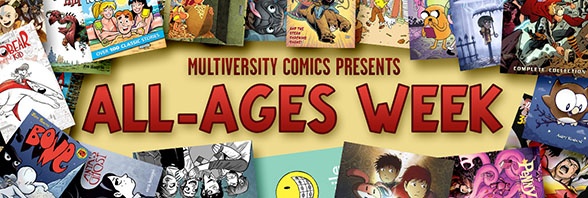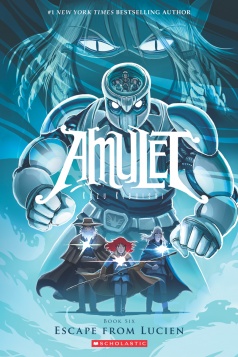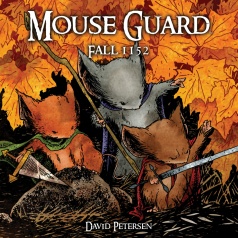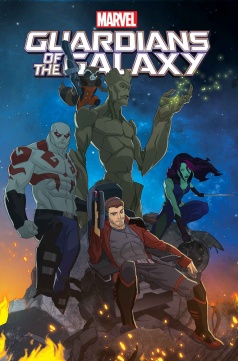
Throughout the week, we’ve highlighted all kinds of aspects of the comic industry and how they impact young readers, from libraries, comic shops and bookstores to publishers, parents and format. But one major aspect we haven’t really looked at is maybe the biggest question of them all: what is it kids want out of their comic reading experience?
Now, there’s no magical answer to that. If there was, I wouldn’t be writing these articles, I’d probably be sitting on a throne made of gold paid for from the millions I made publishing a bevy of New York Times best selling graphic novels for children. But there are elements that you could call, for a lack of a better phrase, the right stuff when it comes to crafting a comic for an all-ages audience. Those things that help inextricably bind readers – of any age – to a work not because they have to read it, but because they love to read it.
But what are they? Let’s find out by examining the experiences and thoughts of several creators who have seen as much success as anyone in all-ages comics, and see if we can find commonalities between them that inspire such passion from their readers.
Raina’s Story
Probably the closest the comics industry has to the Beatles right now is Raina Telgemeier, a cartoonist whose autobiographical graphic novels “Smile” and “Sisters” and fiction graphic novel “Drama” have captured the hearts of readers of all shapes, sizes and ages. I specifically remember the first moment where I realized I had to read one of her books, as I was on Twitter and someone retweeted a video of little girls screaming with joy like the nation’s hottest boy band was in the vicinity, except it was the arrival of Telgemeier that inspired such incendiary excitement out of them.

“The sense I get is that readers see themselves in my stories. I’m just writing about my regular, boring, un-cool life, including my fears and hopes and anxieties and insecurities,” Telgemeier said. “I think my expectation was that my experiences were specific to me, but the reality is that they are more universally relatable than I’d ever imagined. I wish I could go back in time and tell my 12-year-old self I was normal, but I suppose telling these stories gives that reassurance to my readers now.”
Creating a relatable story and characters within it is vitally important in reaching readers of all ages, but readers finding something universal in her own story? That’s not something Telgemeier ever expected, nor was it something she ever planned, as going down the path of autobio comics was something that came together quickly and organically.
“It just sort of happened,” she answered when asked how she got into making comics primarily aimed at younger readers. “I was writing autobiographical short story comics, which grew out of keeping a comic-style journal from middle school on. In my mid 20s, about half of the comics I wrote were about my childhood, and my (adult) readers seemed to respond very strongly to those. I kept going down that road, and it became my career.”
Looking back on “Smile” and how it came together, Telgemeier shared that it “felt like a nostalgia comic when I was writing it, but I guess I was writing in a more current, youthful voice than an ‘adult looking back on childhood’ voice, which seems key to reaching young readers. So, kids today read my books and feel they’re current. Adults read them and see my 80s and 90s childhood peeking through.”
That right there is a pillar of reaching readers of all-ages. Much has been made this week about not talking down to kids, but you don’t want to do that for adult readers either. Finding a middle ground where you respect everyone and deliver the story in a fashion that doesn’t pull any punches is hugely important. It’s why big moments in “Smile” hit as hard as they do. Kids can look at them and feel hope. Adults can look at them and feel that they weren’t alone during a time they thought they were. While some look at both comics and material aimed at kids as some sort of lower class of art, for me, the work Telgemeier has put together isn’t just creatively resonant, they’re important.
Continued belowOne of the the most fascinating things about her work though is how passionate people are about it considering her most popular work are stories from her life, and it’s an interesting experience for her as well.
“It’s definitely surreal. I’m a character, I’m a real person, I’m sharing my memories. That means people feel like they know me really well,” she said. “Of course…I’ve changed a lot in the 20+ years since my stories take place, and I’m not a kid anymore! When I visit schools, kids always ask me how old I am, and they’re shocked when I tell them! I think they’re expecting me to say 21 or 22…young enough that the days I’m writing about weren’t all that long ago.”

“Scholastic is great at what they do: putting books into kids’ hands on a grand scale,” she said. “Kids found my books through Scholastic Book Fairs way before they were a success at the retail level. And Graphix, specifically, has been building an amazing home for kids’ comics over the past decade.”
The immense popularity of her work wasn’t an overnight affair, of course, and her success showcases another key element to reaching younger readers: you have to have patience. Very rarely are books like Harry Potter, exploding early on. Typically, it’s more of a gradual thing.
“Oh, it was a slow build,” Telgemeier said in regards to how her work’s popularity grew. “I mentioned Scholastic Book Fairs before. ‘Smile’ sold a large number of copies through the book fairs in its first season of publication, but it was almost two years before it hit the New York Times bestseller list.”
“In that time, it was also nominated for several state-level student reading awards—and won several of them! So Smile was considered successful from the beginning (meaning, I started earning royalties right away, something that had not happened with my previous work), but it was not a visible, mainstream success for a while. I had a ton of support from within the comics community, but the crossover success with the book and publishing industry at large is more recent.”
It’s easy to look at the success Telgemeier has seen and think, “that’s the playbook for becoming a success in all-ages comics.” But it’s not that simple, as even with a lot of hard work, support and talent on her side, it took time for her to reach the levels she did. And that’s not an altogether uncommon story when it comes to all-ages creators.
Kazu’s Story
“It’s been a slow, steady climb,” shared Kazu Kibuishi, the creator of the enormously popular “Amulet” series. “The series definitely took a while to find its way out in the world. I remember thinking I had failed after seeing how the first book was doing when it came out.”

“Thankfully, the folks at Scholastic had a vision for the series and they continued to show massive support and reassured me as they stuck with it over the years. The first book came out in 2008 but only made it onto the New York Times Bestsellers list for the first time in 2014,” he said. “Making these books has required a lot of patience, but when I began working on them, I really had no interest in doing anything else.”
That last point he made is one I can’t emphasize enough. A big part of why “Amulet” is such an enormous success – and it goes the same for Raina’s work – is that these are passion projects for them. Looking at any two-page splash from “Amulet” or reading the beautiful story arcs of characters like Emily or Navin in his series, you can see that this is an important project to him. He’s telling the story because he has to. Like with any creative project, success is all the more likely if it’s something that’s important to you, and if it isn’t a project the creator cares about, how could readers care?
Continued belowFor Kibuishi, it was also a project that perfectly fit his skillset, making the path to “Amulet” a very natural one for him.
“Stylistically my cartoons looked like material for kids, but the content was made for an older – but not necessarily more mature – audience. It took a while for me to accept that I have a very friendly drawing style and to just embrace it,” he said. “When I realized there weren’t that many new all-ages comics being produced, it seemed like a perfect time to get focused on creating comics for younger readers, playing to the strengths of my drawing style. This is when I made the switch from working on my first series, Daisy Kutter, to book one of Amulet.”

“I began working on Amulet with the intention of following Bone, so Scholastic Graphix seemed like a natural choice to publish the books,” he shared. “Since then, working with Scholastic and their amazing team has been one of the greatest experiences of my professional life. I plan to make graphic novels with them for many years to come.”
While Scholastic/Graphix helped him gain success with his work, the reason he’s seen so much of it is similar to what Telgemeier saw with her work: his books are easy to connect with for readers of all ages.
“I just try to make stories that feature relatable characters making compelling choices,” he said. “We enjoy studying stories to explore choices we would or could make in our own lives and we want a safe space from which to observe the relatable characters make those choices so we can see what happens.”
David’s Story
“’Mouse Guard’ is an underdog thriving story,” said David Petersen, the Eisner winning creator of that aforementioned series. “Mice are very little, have lots of larger-than-life predators, and the world is vast and seemingly unconquerable to them…And I think that’s a sentiment anyone can relate to. Everyone’s bully or challenges seem larger than them, whether you are a kid on the playground talking about a bully or an adult talking about the guy in the office trying to make your job impossible.”
That’s a universal feeling that anyone – including the bullies David mentions – go through in their lives, and it’s an experience that deserves respect, as it’s a hard one to go through for any person. That’s another thing that Petersen sees as an important aspect of finding success with all-ages books: respecting your audience.

“I assume kids can still tell that stuff and I’d guess it rubs them the wrong way like it did me,” he continued. “I think having material that either challenges them a bit or works on multiple levels is something they enjoy…that way they can enjoy it again and feel like they got more out of it a second time, or discovered a new layer of detail of story they missed the first time.”
Giving readers – both young and old – the benefit of the doubt when you’re crafting your story, and assuming that if they’ll figure it out if they don’t know exactly what you’re saying, is hugely important. As Petersen noted, because of the way life works, a great all-ages story can be consistently rewarding in new ways sometimes. That goes for all mediums, as I recently rewatched the movie “Big” and picked up on a rather tawdry joke I never understood as a child, thinking at the time it was just Josh Baskin making the right choice on which part of the bunk bed he wanted to sleep on. It surprised and amused me, and made watching it again an even better experience.
Continued belowBy baking in elements like that into your story – and I’m not advocating adding sex jokes as a foundation of all-ages comics, but rather nuanced humor that ages well – you create an experience that continues to reward past a first read and something that invests parents into the experience as much as the children.
Again, this type of thing isn’t a secret recipe to success in all-ages comics. It’s just a good playbook for quality storytelling in general, which is all Petersen intended from the start. He readily admits that creating an all-ages comic wasn’t his explicit goal as he developed “Mouse Guard”, but something that naturally fit his interests and aesthetic as the book came together.
“I don’t think I had a plan at all really. It was more about following my gut with they type of story I liked,” he said. “I don’t tend to go for overly gory stuff, or anything too violent as a storyteller by nature. I do recall being a little put off when a few early patrons thought it was ‘for kids’ and not liking how that sounded like my work was being written off as something ‘less-than’.”
“It was after issue 1 was self-published and nearly sold out that I realized I had the potential to span a gap that wasn’t being addressed by many comic creators anymore: material for any age,” he added. “So I think my marketing plans changed, but nothing about my story plans or execution changed.”
The Keys to Success
If it’s starting to seem like there’s a theme building here, it’s because there is one. Or several, even. Above all, there were two things that came up more than anything else. One of those is this: kids want to read a story that features character they can relate to, even if it isn’t in obvious ways. I asked Image’s Jennifer de Guzman as to what she thinks kids look to the most, and she immediately circled that idea as the most important one.
“Characters they can relate to. We see that with the prose children’s and young adult book juggernauts and classics. Anne Shirley. Harry Potter. Katniss Everdeen. These characters are aspirational in that they’re capable of great things, but also relatable in that they have to work hard and experience failure and insecurity,” she said. “The worlds they inhabit are also compelling, but those worlds won’t work unless there’s a character to introduce and open it up to readers.”

“Aside from the fact that they look so cool, I think it’s because many of these characters are misunderstood,” Caramagna said. “No matter how much good Spider-Man does, J. Jonah Jameson calls him a menace. The Hulk is big and scary, but he’s good inside, and underneath all that rage is a brilliant scientist. They’re misunderstood the way that kids are often misunderstood, underestimated and forgotten by the grown ups around them, when in fact they’re smarter and more capable than we think they are.”
Manga readers look for the same thing from their experience, shared Beth Kawasaki, Senior Editorial Director of Perfect Square at VIZ Media. “Teamwork and friendship are big themes in a lot of manga, and I think kids really relate to that. Together, the main characters figure out how to take on life’s challenges and make the world a better place.”
That underlines the idea that it’s not just seeing someone like them doing things that engages young readers, but seeing themselves in an aspirational setting. It’s someone like them out on an epic adventure, or accomplishing something great, that helps make comics such an incredible experience for young readers. But as with anything, kids look for one thing above all out of their reading experience, whether its for prose novels or comics: they want a story that’s good.
“Younger readers really aren’t that different from older readers. They just want a good story, like anybody else,” said Kibuishi.
Continued belowScholastic/Graphix’s David Saylor agreed with that wholeheartedly.
“It’s all about telling a good story and combining it with expressive artwork. Storytelling is what appeals to all of us, so if we have a great storyteller drawing and writing a book, then it will find an audience.”
That’s not to say it has to be technically magnificent, but just something that actively engages with readers in a way that keeps their attention, as de Guzman noted.
“I think books like ‘Captain Underpants’ and ‘Diary of a Wimpy Kid’ have shown that the art doesn’t have to be really slick or complex or sophisticated — it just has to have energy,” she said. “Art can be really beautiful and rendered, but if it just sits there, it’s not going to inspire kids to keep looking at it.”
Kids aren’t picky readers. As more and more books bridge the gap between fiction and nonfiction, prose and comic book, reading is becoming one big melting pot of an experience for kids. Children and people of all ages – adults too – just want to be entertained or engaged or excited or thrilled or made to feel something. They don’t want to be turned into inactive observers. They want to be part of something, and it doesn’t matter where they’re getting it.
Thanks to the tireless work of all of the people mentioned this week, as well as many others, that has become a trademark of the comic book experience. They’re delivering what readers want in a way that engages them, and that’s what makes this such an exciting time for comic readers of all-ages.






